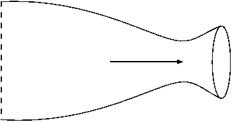Subsonic and supersonic flow – a summary
Now, I think, we are in a position to sum up the essential differences between subsonic and supersonic flow in contracting and expanding ducts, and in similar circumstances such as over aerofoils or other bodies.
|
In a Contracting Duct |
In an Expanding Duct |
|
|
Flow accelerates |
Flow decelerates |
|
|
Subsonic Flow |
Air rarefies slightly |
Air is compressed slightly |
|
Pressure falls |
Pressure rises |
|
|
Flow decelerates |
Flow accelerates |
|
|
Supersonic Flow |
Air is compressed |
Air is rarefied |
|
Pressure rises |
Pressure falls |
In short, everything in supersonic flow is exactly the opposite to subsonic flow with one important exception – in both cases increasing speed goes with decreasing pressure. So Bernoulli’s principle, which at low speeds is really the conservation of energy, has still some significance (though modifications are needed before it can be applied quantitatively in compressible flow).
Notice, too, that what happens in supersonic flow is what we said in an earlier chapter was what common sense might lead us to expect – a decrease of speed and compression at the throat of a venturi. It is some measure of our learning and understanding of the subject if by now this is no longer common sense!
|
|












